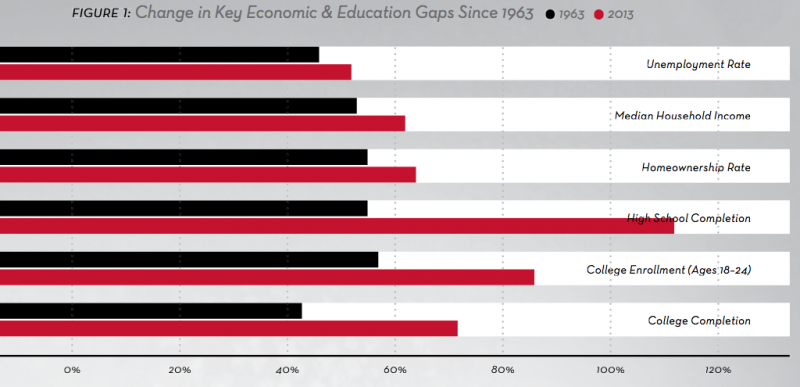2013
Since 1963, blacks have experienced tremendous gains in school enrollment and educational attainment. Fifty years ago, only one-quarter of black adults had completed high school. Currently, only 15% of black adults are not high school completers. At the college level, there are now 3.5 times more black 18–24 year olds enrolled in college than in 1963, and 5 times as many black adults1 hold a college degree now than in 1963. Increased access to educational and employment opportunities, brought about as a result of the Civil Rights Movement and a rmative action policies, have significantly raised the standard of living for black Americans over the last 50 years. Since 1963, the percentage of blacks living in poverty has fallen by nearly half (45%), and the percentage of black children living in poverty is down by more than one-third.
Despite notable absolute progress for Black America, there has been much less relative progress toward economic equality with whites, especially when compared to the progress made toward educational equality. In nearly 50 years, the unemployment rate gap has only closed by 6 percentage points (now at 52%), the income gap has only closed by 7 percentage points (now at 60%), and the homeownership rate gap has only closed by 6 percentage points (now at 61%). At the same time, the high school completion gap has closed by 57 percentage points (now at 112%), the college enrollment gap has closed by 30 percentage points (now at 81%) and the college graduate gap has closed by 20 percentage points (now at 62%). Put simply, African Americans have achieved much less economic parity with whites than educational parity (Figure 1). And in fact, the total 2013 Equality Index of Black America stands at 71.7%, meaning that on average, African Americans enjoy less than three-fourths of the benefi ts and privileges o ered to white Americans. It is these persistent gaps, particularly in economic outcomes, that lead us to take a closer look at current racial gaps in unemployment and income vis-á-vis di erences in education, economic status, and geographic location.


 Equality Index
Equality Index  Senate Report
Senate Report  2020 SOBA Essays
2020 SOBA Essays  2019 Report
2019 Report 